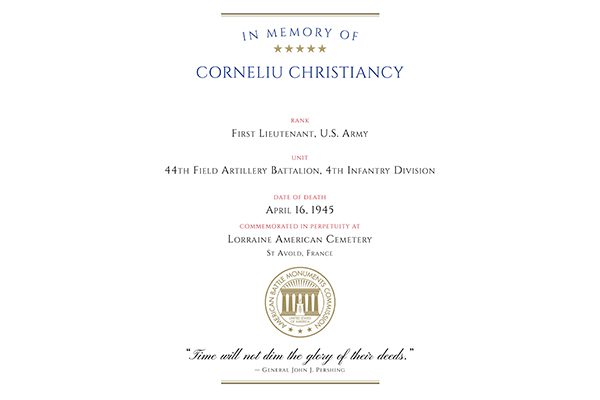Cornelius “Neil” Christiancy

“I never knew my great uncle Neil. He was my grandfather’s brother, and he died in the war – before my mother was born. But I have heard stories about him over the years.
He was apparently very witty and fun and smart; he graduated from Princeton University in 1931. One thing that always fascinated me was that he was color blind, which normally would have been a hindrance. But during WWII, it was discovered that color-blind soldiers had an advantage in that they could not be fooled by camouflage. Many, like my great uncle Neil, were therefore assigned as artillery unit forward observers – a very important but extremely dangerous duty.”
– Heather Perry, Associate Professor, College of Liberal Arts & Sciences
Cornelius “Neil” Christiancy, remembered by his great niece, Heather Perry
Bronze star recipient Cornelius “Neil” Christiancy was known as a “wonder” among infantrymen.
Cornelius “Neil” Christiancy volunteered for World War II, and he was in the 4th Infantry Division, also known as the Ivy Division because the Roman numeral “4” is written as “IV.” As a first lieutenant, he was assigned to the 44th Field Artillery Battalion and served as a forward observer; he was among those who landed at Utah Beach, the westernmost landing area of the Normandy Invasion.
Christiancy received the Bronze Star for heroic achievement while under heavy fire for two days, and was also awarded the Silver Star as well as a Purple Heart with Oak Leaf Cluster. His major wrote of him: “He was extremely popular. The Infantry swore by him. In the Schnee Eifel Forest north of Brandscheid last September [1944], he became the most talked-of artilleryman in the 22nd Combat Team. He fired between 1,500 and 1,600 rounds of ammunition in one day, and all on profitable targets. He was a wonder.”
Christiancy was injured and died on April 16, 1945, just a couple of weeks before the war’s end; he is buried in the Lorraine American Cemetery, outside Saint-Avold, France.